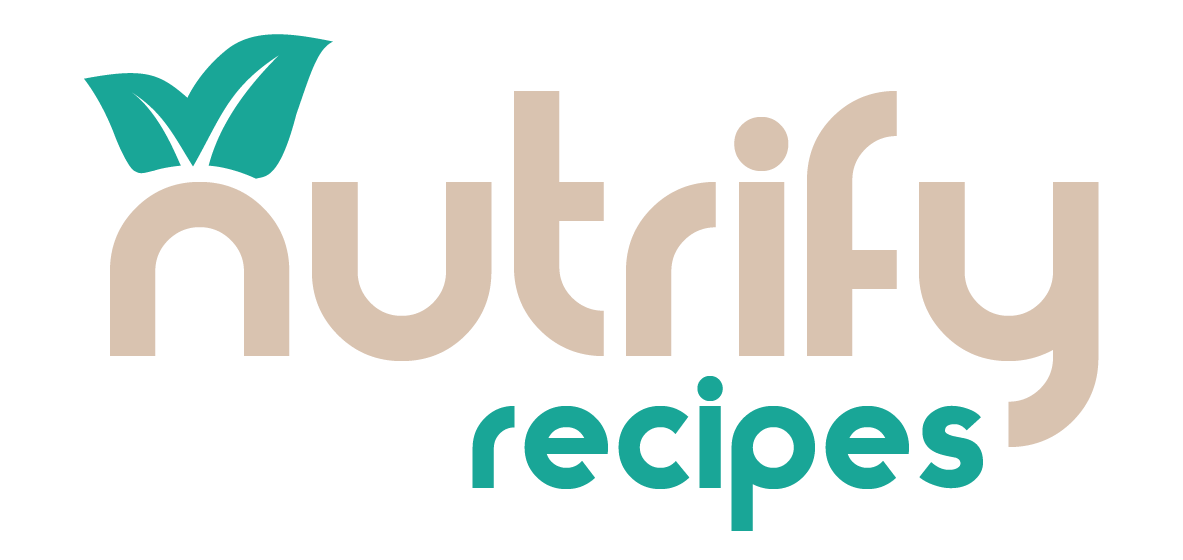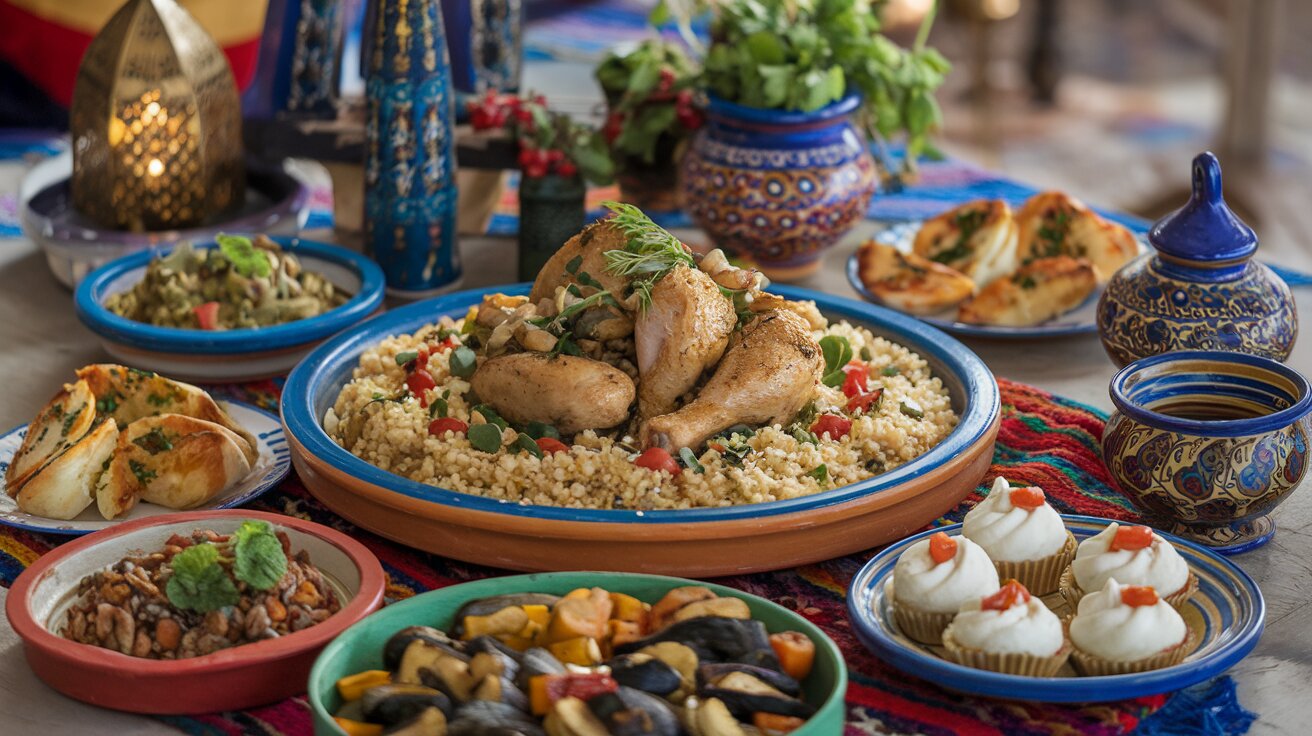What to Serve with Chicken Couscous: Perfect Pairings for a Moroccan Feast
Wondering what to serve with chicken couscous to create a complete and satisfying meal? Moroccan chicken couscous is a flavorful dish that combines tender chicken, fluffy couscous, and aromatic spices, making it a centerpiece for any gathering. To truly enhance its flavors, pairing it with the right sides, drinks, and desserts is essential.
Introduction to Moroccan Cuisine
Moroccan cuisine is a treasure trove of flavors and culinary traditions, deeply rooted in the country’s history and culture. Influenced by Berber, Arab, and Mediterranean cuisines, Moroccan dishes are celebrated for their rich use of spices, fresh ingredients, and unique cooking methods.
At the heart of this cuisine lies couscous, Morocco’s national dish, which is often paired with various meats, vegetables, and aromatic broths. If you’re wondering what to serve with chicken couscous, the answer lies in the rich variety of Moroccan sides, soups, and breads that complement its comforting blend of flavors.
Chicken couscous is particularly popular for its combination of tender chicken, seasonal vegetables, and a fluffy base of semolina grains. Knowing what to serve with chicken couscous can transform this dish from a simple meal into a full culinary experience.
The magic of Moroccan cuisine lies in its ability to bring people together. Couscous is traditionally served in a large communal dish, symbolizing unity and hospitality. However, the experience doesn’t end with the main dish. Moroccan meals are known for their elaborate accompaniments, including soups, salads, breads, and desserts—all designed to create a perfect balance of flavors and textures.
To fully appreciate what to serve with chicken couscous, let’s start with the warm and hearty soups that make an excellent appetizer for this iconic dish.
Best Soups to Serve with Chicken Couscous
A Moroccan meal often begins with a bowl of steaming soup, setting the tone for the rest of the feast. These soups are not only delicious but also nourishing, perfectly complementing the light, fluffy texture of couscous.
Harira: The Quintessential Moroccan Soup
One of the most famous soups in Morocco is harira, a rich, tomato-based soup made with lentils, chickpeas, and a blend of warming spices. Harira is often enjoyed during Ramadan to break the fast, but it’s also a favorite starter for celebratory meals. Its hearty texture and tangy flavor create a delightful contrast to the mildness of chicken couscous.
Why It Works: Harira’s depth of flavor enhances the spices in couscous, creating a cohesive and satisfying meal.
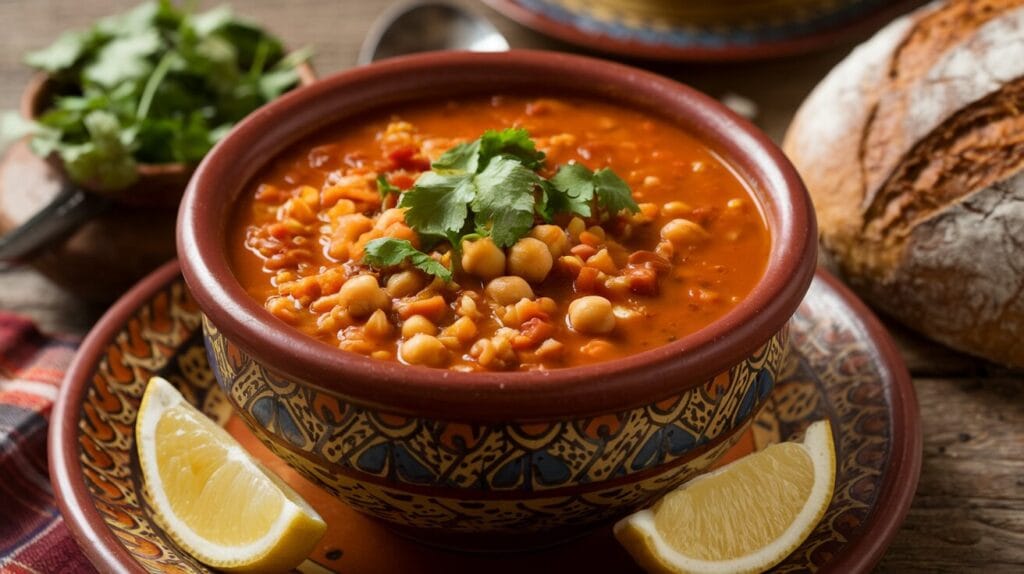
Lentil Soup with Spices
Another excellent choice is Moroccan-style lentil soup, which is mildly spiced and packed with nutrients. Made with red or green lentils, tomatoes, garlic, and cumin, this soup is both simple and flavorful. It’s perfect for those who enjoy lighter starters.
Why It Works: The creamy, earthy texture of lentil soup pairs well with the grains of couscous, providing a comforting combination.
Vegetable Soup with Herbs
For a lighter option, a vegetable soup infused with fresh herbs like parsley and cilantro is an ideal choice. This soup typically includes a mix of seasonal vegetables such as zucchini, carrots, and potatoes, creating a broth that’s both refreshing and flavorful.
Why It Works: Vegetable soup mirrors the fresh, wholesome ingredients in couscous, offering a harmonious pairing.
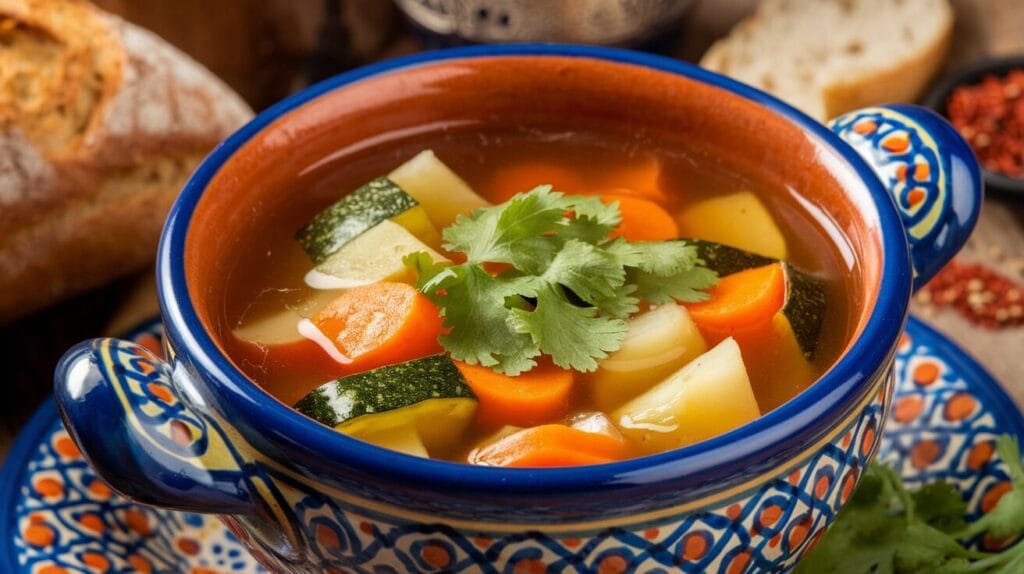
Why Soups Complement Chicken Couscous
When deciding what to serve with chicken couscous, soups are an excellent choice that stands out. In Moroccan cuisine, soups play a vital role—not just as appetizers but also as palate warmers that prepare diners for the main course. Their brothy consistency and bold flavors provide a delightful contrast to the grainy texture of couscous, making them a perfect match for this iconic dish.
Starting your meal with a hearty soup like harira or lentil soup is one of the best ways to enhance the dining experience. These soups not only complement chicken couscous but also create a layered meal that celebrates the rich traditions of Moroccan cooking.
Vegetable Sides and Salads for Couscous
No Moroccan feast is complete without an array of vibrant and flavorful vegetable sides and salads. These dishes are more than just accompaniments—they are essential components that elevate the couscous dining experience. The fresh, zesty, and spiced flavors of Moroccan vegetable sides perfectly balance the hearty nature of chicken couscous, adding layers of texture and taste to the meal.
Here are some of the best vegetable sides and salads to serve with chicken couscous.
Zaalouk: A Classic Eggplant Side Dish
Zaalouk is a traditional Moroccan eggplant and tomato dip that’s bursting with smoky, tangy, and slightly spicy flavors. Made by roasting eggplants and combining them with tomatoes, garlic, olive oil, and spices like paprika and cumin, zaalouk is a must-try side dish.
Why It Works: The creamy texture and bold flavor of zaalouk provide a wonderful contrast to the fluffy, mild couscous. It also acts as a dipping option when served with bread, adding versatility to the meal.
Quick Recipe:
- Roast or grill two eggplants until the skin is charred and the flesh is soft.
- Peel the skin and mash the eggplant.
- In a skillet, sauté garlic in olive oil, add diced tomatoes, and cook until soft.
- Mix in the mashed eggplant, add spices (paprika, cumin, salt), and simmer until thickened.
- Finish with a drizzle of olive oil and garnish with fresh parsley.
Carrot Salad with Orange and Cinnamon
This Moroccan carrot salad is a delightful combination of sweet, tangy, and aromatic flavors. Thinly sliced carrots are tossed with orange juice, a touch of honey, and a hint of cinnamon, creating a dish that’s both refreshing and unique.
Why It Works: The sweetness of the carrots complements the savory and spiced flavors of chicken couscous, adding a bright and refreshing element to the meal.
Quick Recipe:
- Slice carrots thinly or grate them into strips.
- In a bowl, whisk together orange juice, honey, olive oil, and a pinch of cinnamon.
- Toss the carrots in the dressing and let them marinate for 20–30 minutes.
- Garnish with fresh mint leaves or orange zest before serving.
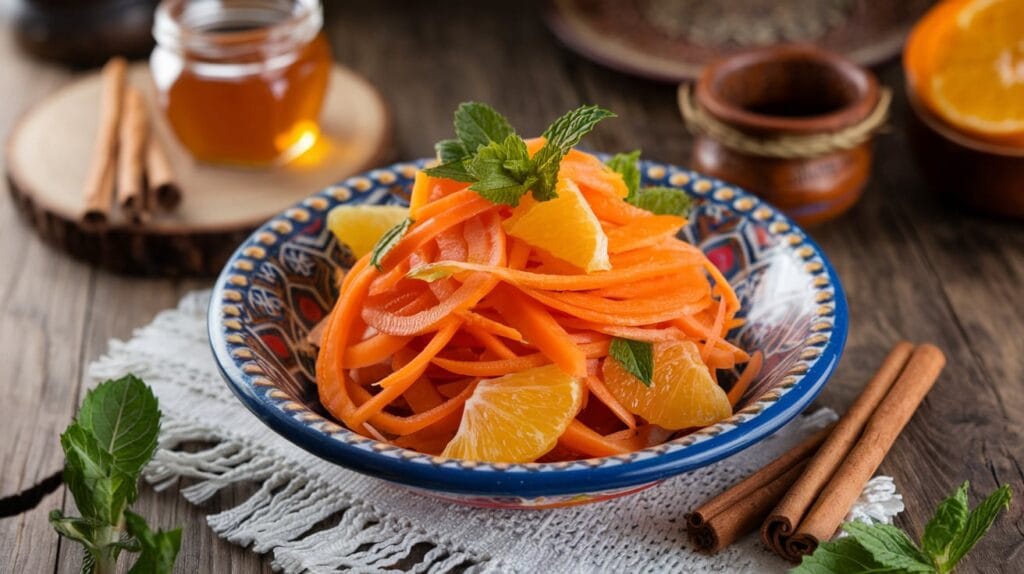
Roasted Vegetables with Moroccan Spices
A medley of roasted vegetables, such as zucchini, bell peppers, carrots, and sweet potatoes, seasoned with Moroccan spices, makes a wholesome and delicious side dish. Roasting intensifies the natural sweetness of the vegetables while the spices add a warm, earthy flavor.
Why It Works: Roasted vegetables add a hearty and smoky dimension to the meal, complementing the flavors of the chicken and couscous beautifully.
Quick Recipe:
- Chop your choice of vegetables into bite-sized pieces.
- Toss with olive oil, cumin, paprika, and salt.
- Spread on a baking sheet and roast at 400°F (200°C) for 25–30 minutes.
- Serve warm, garnished with fresh herbs like parsley or cilantro.
Simple Moroccan Tomato and Cucumber Salad
This light and refreshing salad is a staple in Moroccan cuisine. Made with diced tomatoes, cucumbers, red onion, and a simple vinaigrette, it’s a great way to add a fresh element to your chicken couscous meal.
Why It Works: The crispness of the cucumbers and the juiciness of the tomatoes provide a refreshing contrast to the warm, hearty couscous.
Quick Recipe:
- Dice tomatoes, cucumbers, and red onion.
- In a small bowl, whisk together olive oil, lemon juice, salt, and pepper.
- Toss the vegetables in the vinaigrette and garnish with chopped mint or parsley.
The Role of Vegetable Sides in Moroccan Meals
Vegetable sides and salads are essential in Moroccan cuisine because they offer balance and variety. Their freshness offsets the rich, spiced flavors of the main dish, while their vibrant colors make the meal visually appealing.
When served alongside chicken couscous, these vegetable dishes not only enhance the flavors but also provide a nutritious, well-rounded dining experience.
Bread Pairings: A Staple of Moroccan Meals
Bread, or khobz in Arabic, is an integral part of Moroccan dining culture. It’s more than just an accompaniment; it serves as a utensil to scoop up food, soak up sauces, and add texture to meals. Moroccan breads come in many forms, from crusty loaves to flaky flatbreads, each bringing a unique flavor and texture to the table.
When paired with chicken couscous, bread adds an extra layer of indulgence, allowing diners to enjoy the rich broth or sauces from the couscous. Let’s explore some traditional Moroccan breads and how to make them at home.
Khobz: The Everyday Moroccan Bread
Khobz is a round, crusty bread commonly found in Moroccan households. It has a dense yet soft texture, making it ideal for scooping up couscous or mopping up sauces. The bread is baked in a clay oven or a home oven and is often flavored with semolina for a slightly nutty taste.
Why It Works: The sturdy texture of khobz complements the light, fluffy couscous and absorbs the rich flavors of the broth beautifully.
Quick Recipe:
- Mix 2 cups of semolina, 2 cups of flour, 2 teaspoons of sugar, and 1 teaspoon of salt in a bowl.
- Add 1 tablespoon of yeast and gradually pour in warm water, kneading until the dough is smooth.
- Let the dough rise for an hour, then shape it into round loaves.
- Sprinkle with semolina and bake at 375°F (190°C) for 20–25 minutes until golden brown.
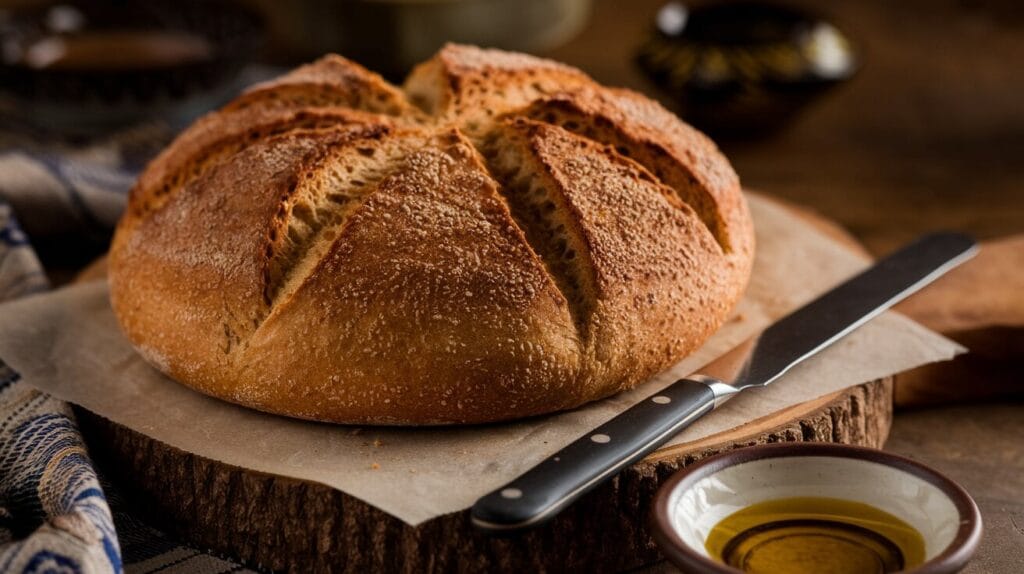
Msemen: Moroccan Flatbread
Msemen is a flaky, pan-fried flatbread often enjoyed during breakfast or alongside meals. It’s made by folding and layering dough with butter and semolina, resulting in a crispy, layered texture.
Why It Works: The buttery, flaky texture of msemen adds richness to the couscous meal and works well for scooping up vegetables or sauces.
Quick Recipe:
- Mix flour, semolina, sugar, salt, and yeast to form a soft dough.
- Divide the dough into small balls and let rest.
- Flatten each ball, brush with melted butter, sprinkle with semolina, and fold into a square.
- Cook on a hot griddle until golden brown on both sides.
Batbout: Moroccan Pita Bread
Batbout is a soft, fluffy bread similar to pita, cooked on a stovetop rather than baked. It’s perfect for stuffing with salads or dips to serve alongside couscous.
Why It Works: Its pillowy texture contrasts with the grainy couscous, offering a delightful chewiness that enhances the overall meal.
Quick Recipe:
- Combine 2 cups of flour, 1 cup of semolina, 1 tablespoon of sugar, 1 teaspoon of salt, and 1 tablespoon of yeast.
- Add warm water and knead until smooth. Let rise for 1 hour.
- Roll out into small circles and cook on a hot skillet until puffed and golden.
Harcha: Moroccan Semolina Bread
Harcha is a pan-fried semolina bread with a crumbly texture. It’s slightly sweet and often served with butter and honey, but it can also be a savory option to pair with couscous.
Why It Works: Its crumbly, buttery texture is a unique complement to the moist and flavorful couscous.
Quick Recipe:
- Mix semolina, sugar, baking powder, salt, and melted butter.
- Add milk gradually to form a soft dough.
- Shape into small disks and cook on a griddle until golden brown.
The Importance of Bread in Moroccan Dining
In Moroccan culture, bread isn’t just a side—it’s an essential part of the dining experience. Its versatility and ability to complement every element of the meal make it indispensable. Bread also plays a social role, as sharing bread at the table fosters a sense of community and hospitality.
When serving chicken couscous, offering a variety of breads like khobz, msemen, or batbout ensures that your meal is both traditional and satisfying.
The Perfect Drinks to Serve with Chicken Couscous
When considering what to serve with chicken couscous, the right drink can elevate the meal to new heights. In Moroccan cuisine, beverages are more than just thirst-quenchers—they play a central role in completing the dining experience. From the soothing aroma of freshly brewed mint tea to the refreshing zing of citrus-based juices, the perfect drink balances the richness of the food and refreshes the palate.
Pairing chicken couscous with traditional Moroccan beverages not only complements the dish but also transports your guests to the heart of Morocco. Whether it’s a warm glass of mint tea or a chilled orange blossom lemonade, these drink options are sure to enhance your couscous feast.
Moroccan Mint Tea: The Iconic Beverage
Known as atay b’naanaa, Moroccan mint tea is a staple of Moroccan hospitality. Made by brewing green tea with fresh mint leaves and sweetened generously with sugar, this aromatic drink is served throughout the day and during meals.
Why It Works: The light, refreshing taste of mint tea cuts through the hearty flavors of chicken couscous, cleansing the palate and enhancing the meal.
How to Make Moroccan Mint Tea:
- Rinse 1 tablespoon of green tea leaves with boiling water to remove bitterness.
- Add the tea to a teapot, along with a handful of fresh mint leaves and sugar to taste.
- Pour boiling water into the teapot and let it steep for 3–5 minutes.
- Pour the tea into glasses from a height to create a frothy layer on top.
Orange Blossom Lemonade
Moroccan lemonade infused with orange blossom water is a refreshing and fragrant drink that pairs wonderfully with couscous. The citrusy flavors and floral notes create a delightful balance to the meal.
Why It Works: The tangy and slightly sweet taste of the lemonade complements the spices in chicken couscous, while the floral aroma adds an exotic touch.
Quick Recipe:
- Mix the juice of 4 lemons, 4 tablespoons of sugar, and 1 tablespoon of orange blossom water.
- Add cold water and stir until the sugar dissolves.
- Serve over ice and garnish with lemon slices or fresh mint.
Freshly Squeezed Orange Juice
For a more indulgent option, when considering what to serve with chicken couscous, try a Moroccan date smoothie. Blended with milk, dates, and a hint of cinnamon, this creamy and satisfying drink is a unique addition to your couscous meal.
Why It Works: The natural sweetness of orange juice offsets the savory and spiced flavors of couscous, offering a refreshing contrast.
Quick Preparation:
- Squeeze fresh oranges and strain the juice if desired.
- Serve chilled or over ice for a refreshing burst of flavor.
Date Smoothie: A Sweet and Nutritious Treat
For a more indulgent option, try a Moroccan date smoothie. Blended with milk, dates, and a hint of cinnamon, this drink is creamy and satisfying, making it a unique addition to your couscous meal.
Why It Works: The creamy texture and sweet flavor of the smoothie provide a comforting contrast to the grainy couscous and spiced chicken.
Quick Recipe:
- Blend 1 cup of milk, 5–6 pitted dates, and a pinch of cinnamon until smooth.
- Add ice cubes and blend again for a chilled version.
- Serve garnished with a sprinkle of cinnamon.
Spiced Moroccan Coffee (Nous-Nous)
Nous-nous, meaning “half-half,” is a Moroccan coffee made with equal parts espresso and milk. It’s typically served in small glasses and enjoyed as an after-meal beverage.
Why It Works: The rich, spiced aroma of nous-nous is a perfect ending to a hearty meal, especially for coffee lovers.
Quick Recipe:
- Brew a shot of espresso.
- Heat an equal amount of milk and froth it slightly.
- Pour the milk over the espresso and serve immediately.
The Role of Drinks in Moroccan Dining
Beverages in Moroccan cuisine are more than just thirst-quenchers; they enhance the flavors of the meal, create a sense of balance, and contribute to the cultural experience. If you’re deciding what to serve with chicken couscous, drinks like mint tea, orange juice, and date smoothies are excellent choices. From the ritualistic serving of mint tea to the vibrant flavors of citrus juices, beverages are an essential part of the Moroccan table.
Offering a variety of drinks when serving chicken couscous ensures that every guest finds their perfect pairing and adds a refreshing touch to the meal.
Desserts That Complete the Feast
No Moroccan meal is truly complete without a selection of traditional desserts. If you’re wondering what to serve with chicken couscous to end the meal on a sweet note, Moroccan desserts are the perfect choice. These sweet treats, often infused with honey, almonds, or fragrant spices, play a significant role in Moroccan dining, balancing the savory flavors of couscous with sweetness and texture.
Here are some traditional Moroccan desserts that pair beautifully with chicken couscous and complete the feast.
Chebakia: Sweet and Spiced Sesame Cookies
When deciding what to serve with chicken couscous for dessert, chebakia is an irresistible choice. This deep-fried Moroccan pastry, coated in honey and sprinkled with sesame seeds, is a staple of festive occasions and pairs beautifully with the warm, spiced flavors of couscous.
Why It Works
The floral and nutty flavors of chebakia harmonize with the spices in chicken couscous, offering a sweet and satisfying contrast. As a dessert, chebakia adds a delightful finish to your Moroccan feast, balancing savory and sweet elements.
Quick Recipe
- Mix flour, ground cinnamon, anise, and orange blossom water into a dough.
- Shape into intricate patterns, fry until golden, and coat in honey.
- Garnish with sesame seeds and serve.
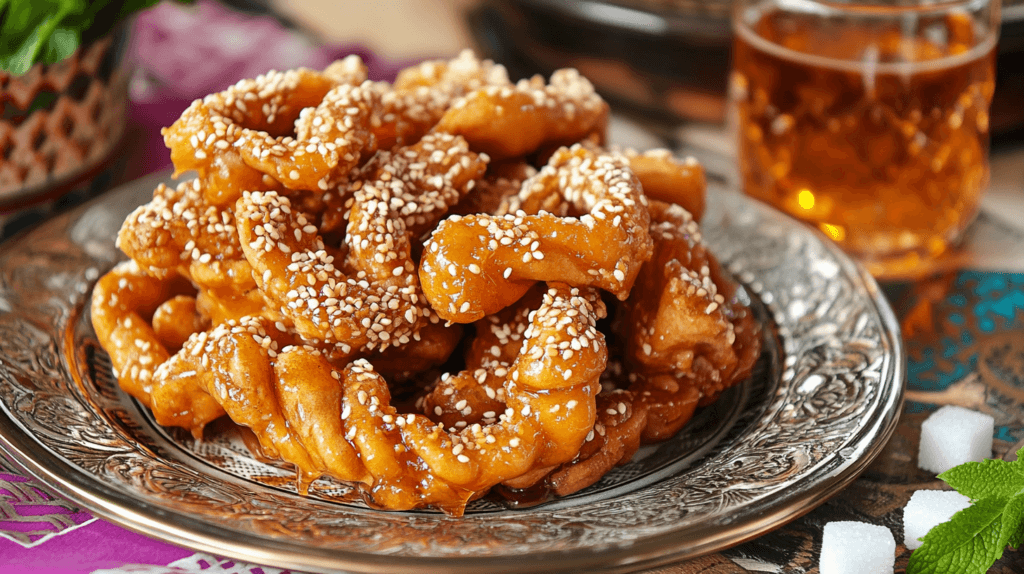
Almond Briouats: Sweet Pastry Triangles
Briouats are small, triangular pastries filled with almond paste and coated in honey. These crispy treats are often served with mint tea during celebrations.
Why It Works: The rich almond filling complements the light, savory flavors of chicken couscous, while the crisp pastry adds a textural contrast.
Quick Recipe:
- Mix ground almonds with sugar, cinnamon, and orange blossom water to form a paste.
- Wrap the filling in thin pastry sheets (warqa) and fry until golden.
- Dip in warm honey and let cool before serving.
Moroccan Orange Slices with Cinnamon
For a lighter dessert option, serve fresh orange slices sprinkled with cinnamon and a touch of orange blossom water. This simple dish highlights the natural sweetness of Moroccan oranges.
Why It Works: The zesty freshness of the oranges cleanses the palate, making it a refreshing end to a rich meal.
Quick Preparation:
- Peel and slice fresh oranges into rounds.
- Sprinkle with ground cinnamon and drizzle with orange blossom water.
- Garnish with fresh mint leaves if desired.
Mhancha: Moroccan Almond Snake Pastry
Mhancha (meaning “snake”) is a spiral-shaped pastry filled with almond paste and flavored with cinnamon and orange blossom water. Its intricate design makes it a show-stopping dessert.
Why It Works: The sweet almond filling and flaky pastry are a perfect complement to the savory, spiced flavors of chicken couscous.
FAQs: What You Need to Know About Serving Chicken Couscous
- What are the best vegetables to serve with chicken couscous?
Roasted vegetables like carrots, zucchini, and sweet potatoes, as well as classic Moroccan dishes like zaalouk or carrot salad, are excellent options. - Can I serve chicken couscous with other grains?
While couscous is traditional, you can experiment with alternatives like quinoa or bulgur for a modern twist. - What drinks pair best with chicken couscous?
Moroccan mint tea, freshly squeezed orange juice, or date smoothies are perfect pairings. - What bread is commonly served with couscous?
Khobz, msemen, and batbout are popular Moroccan breads that pair beautifully with couscous. - What’s a quick dessert option for a couscous meal?
Fresh orange slices with cinnamon and orange blossom water are an easy yet authentic choice. - Can I make chicken couscous vegetarian-friendly?
Absolutely! Replace chicken with chickpeas or a mix of roasted vegetables for a delicious vegetarian couscous.
Conclusion: Elevate Your Chicken Couscous Experience
If you’re wondering what to serve with chicken couscous, this guide offers the perfect roadmap to transform your meal into a rich and vibrant Moroccan dining experience. Chicken couscous is more than just a dish; it’s an invitation to explore the bold flavors, cultural traditions, and warm hospitality of Moroccan cuisine.
By pairing this iconic dish with complementary sides like smoky zaalouk, refreshing beverages like mint tea, and indulgent desserts like chebakia, you can create an unforgettable feast. Each pairing enhances the flavors of chicken couscous, balancing savory and sweet, soft and crisp.
Don’t overlook the cultural significance of bread and mint tea, which add authenticity and warmth to your Moroccan table. With this guide, you’re ready to serve chicken couscous in a way that captures the magic of Morocco. Gather your family and friends, prepare these delightful pairings, and let the journey to Morocco begin—right from your own kitchen!
